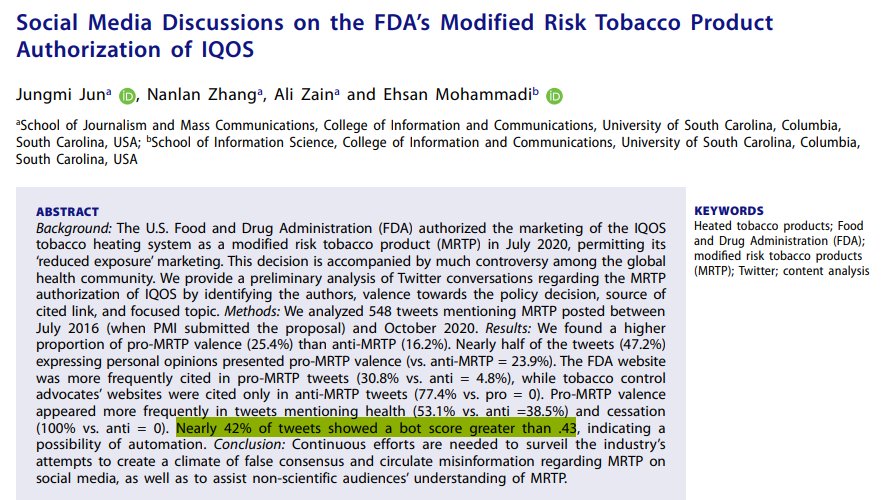Sigh.. Got caught up investigating and debunking the lies in this @truthinitiative ('Truth' 🙄) misinfographic.
A 🧵
A 🧵

The infographic provides the 'sciencese' of providing references to fool the unwary. Their case falls apart though, if those references are actually examined.
Starting with the first three:
Starting with the first three:

Reference 1 (refs listed towards bottom of misinfographic) is: "Nicotine modulation of fear memories and anxiety: Implications for learning and anxiety disorders"
Conclusion: Invalid ref. Modulate ≠ Amplify. Lying by omission.
pubmed.ncbi.nlm.nih.gov/26231942/
Conclusion: Invalid ref. Modulate ≠ Amplify. Lying by omission.
pubmed.ncbi.nlm.nih.gov/26231942/

Reference 2 is: "Bi-directional associations of electronic and combustible cigarette use onset patterns with depressive symptoms in adolescents"
Conclusion: Invalid. BI-DIRECTIONAL ASSOCIATIONS cannot be used as evidence of much at all.
ncbi.nlm.nih.gov/pmc/articles/P…
Conclusion: Invalid. BI-DIRECTIONAL ASSOCIATIONS cannot be used as evidence of much at all.
ncbi.nlm.nih.gov/pmc/articles/P…

But to expand on that a little:
a) Associations between two things tell us little..
a) Associations between two things tell us little..
However ..
b) Bi-directional implies that the two amplify and play into each other. It is not a simple A ➡️ B relationship, but A ↔ B.
b) Bi-directional implies that the two amplify and play into each other. It is not a simple A ➡️ B relationship, but A ↔ B.
Reference 4 is: "Nicotine Addiction"
Conclusion: Invalid. Reduces ≠ Amplify
nejm.org/doi/full/10.10…
Conclusion: Invalid. Reduces ≠ Amplify
nejm.org/doi/full/10.10…

But then we come to..
Reference 3: "Truth initiative Mental Health x Vaping Headline Survey Internal Data."
I'm not even sure what 'headline' is supposed to mean hear. The (dire) conclusions will be 'headlined' by 'Truth'? They did a survey of headlines they saw in media? ..
Reference 3: "Truth initiative Mental Health x Vaping Headline Survey Internal Data."
I'm not even sure what 'headline' is supposed to mean hear. The (dire) conclusions will be 'headlined' by 'Truth'? They did a survey of headlines they saw in media? ..

But no mind, all we need to know is expressed in "Survey Internal Data".
Surveys are inherently unreliable ways to collect data. The respondents may not understand the questions and be provided poor instructions on how to answer the questions when uncertain.
Surveys are inherently unreliable ways to collect data. The respondents may not understand the questions and be provided poor instructions on how to answer the questions when uncertain.
To attain any claim of doing science, a survey would need to abide the following preconditions:
1) Provide the raw (anonymised) data on which the stats were performed.
2) Provide the text of the questionnaire which produced those results.
3) Be peer reviewed (and published).
1) Provide the raw (anonymised) data on which the stats were performed.
2) Provide the text of the questionnaire which produced those results.
3) Be peer reviewed (and published).
Internal survey results fit exactly /none/ of those preconditions.
Two out of three ain't bad, but zero out of three sure ain't science.
Two out of three ain't bad, but zero out of three sure ain't science.
But to compound their disingenuous monologue: They segue direct from "[ppl] said they STARTED vaping to DECREASE stress, anxiety or depression" to talking about how QUITTING nicotine consumption can REDUCE those feelings.
'Truth' Logic ≠ Earth Logic
🧵 /fin/
'Truth' Logic ≠ Earth Logic
🧵 /fin/
unroll, pls @threadreaderapp, you benevolent bot.
• • •
Missing some Tweet in this thread? You can try to
force a refresh












